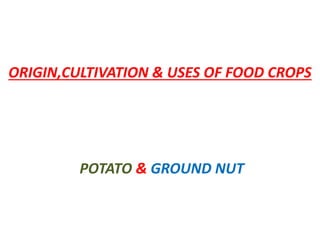
Origin,cultivation & uses of food crops ....potato
- 1. ORIGIN,CULTIVATION & USES OF FOOD CROPS POTATO & GROUND NUT
- 2. CONTENT • INTRODUCTION 1. Potato :- -Classification -Origin -Morphology -Uses 2. Ground nut:- -Classification -Origin -Morphology -Uses
- 3. INTRODUCTION • FOOD :- • It is the basic requirement of life to survive. • It is made up various kind of energy rich substances like carbohydrates, proteins, fats , vitamins & minerals, which are known as nutrients. • FUNCTION OF FOOD :- • Food provide energy for various metabolic activities. • It help in growth & development of body.
- 4. • It help in the replacement of worn out tissues , repair of damaged cells and healing of wounds. • It provide protection against diseases. • SOURCES OF FOOD :- • CEREALS ( Wheat) • PULSES ( Chick pea) • VEGETABLES (Potato) • OIL SEED CROPS ( Ground nut)
- 5. POTATO • scientific name :- solanum tuberosum Linn • local name :- batata • Family :- solanaceae. • Useful organ :- tuber
- 6. ORIGIN • The potato was first domesticated in the region of modern day southern peru and northwestern Bolivia. • It is native American species & was cultivated form chile to new Granda at the time the Spanish explores reached this continent. • The potato was first introduced into new England by lrish immigrants 1719. • Potatoes are usually propagated vegetatively by means of tuber or parts of tuber so called “seed potatoes”.
- 7. MORPHOLOGY • The potato plant is an erect, branching and spreading height of 1-1.25m • The leaves are pinnately compound & densely hair when young. • The tuber are greatly enlarge underground stem & they bear a eyes in the axile scale like leaves which are shed leaving a rudimentaly leaf scar.
- 8. • The flower are born in terminal clusters and the fruit is berry. • The size , color and shape of the tuber varies according to the cultivar.
- 9. CULTIVATION • The best environment for crop is a cool , moist climate , with a mean annual temperature of 40˚- 50˚F. • Potatoes are grown by tuber pieces. • The tuber continues to develop till the plant dies. • The tubers are then stored, preferably in cold stored where temperature is between 36˚ to 38˚ F.
- 10. USES • The tubers are used as vegetable. • Small tubers are utilized for production of starch and industrial alcohol. • It is a good source of vitamins B1, B2 & B6 and minerals such as potassium, phosphorus and magnesium. • The potato is a moderate source of iron, and it has high vitamin C. • They are also used for domestic animals. • Potato chips made from fresh potatoes its called katri.
- 11. Potato is universal table food. • Potato leaf haulms are useful source of cellulose. • Potato are used as antiscorbutic, aperient , diuretic. • Potato is among richest foods in potassium. • Extract of leaves is used as antispasmodic in cough.
- 12. GROUNDNUT • Scientific name :- Arachis hypogaea Linn • Local name :- Peanut • Family :- Leguminosae (papilionaceae/fabaceae) • Useful organ :- Seed
- 13. ORIGIN • Ground nut is native to Brazil. • It is widely distributed throughout in the south America. • Ground nut is widely cultivated in all tropical & sub tropical countries of the world. • India is the largest producer of ground nut. • It is also grown in Burma , Argentina and Thailand.
- 14. MORPHOLOGY • It is annual herb , attaining a height of 0.30 – 0.6m • The leaves are quadrifoliate with two pairs of leaflets on a slender , grooved petiole. • The lemon yellow & sessile flower are born in the axils of leaves on short branches. • The flower bearing branches thrust underground after fertilization & the formation of fruit does not take place unit the ovary is pusnea under the soil.
- 15. • The fruit is an elongated , oblong , indehiscent pod , containing 1 -3 seeds.
- 16. CULTIVATION • The orange – veined , yellow pealed , pea like flower of peanut is born in axillaries' clusters above ground. • Following self pollination , the flowers become weak. • The stalk at the base of the ovary called the pedicel, elongates rapidly and turn downward to hide the fruits several inches in ground , where they complete their development. • The entire plant including most of the roots , is removed from the soil during harvesting.
- 17. • The fruits have wrinkled husk that are rigid between pairs of the one or four seeds per pod. • Peanut grow best in light , sandy loam soil. • They require 5 month of warm weather & an annual rainfall 500 – 1,000 mm ( 20 to 39 inches) or the equal in irrigation water. • The pond ripen 120 to 150 days after the seeds are planted.
- 18. USES • The seed are used for roasting or salting and for the preparation of peanut butter. • The filter refined oil is used for cooking in making margarine. • Peanut oil is important as a food oil. • The protein in peanut is used in the manufacture of a synthetic fiber. • The vegetable ghee is made from the peanut oil after hydrogenation. • Peanut oil also uses as a lubricant.
- 19. • Peanut flour is lower in fat than peanut butter, and is popular with chefs because its high protein content make it suitable as a flavor enhancer. • Peanut flour is used as a gluten – free solution. • Some commercial products are ground nut milk, ice cream.
- 20. REFERENCES • Economic Botany. - B.P.PADAY • Economic Botany. - ALBERT. F. HILL www. Wikipedia. Com www. Slid share . com
- 21. THANK YOU